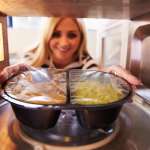In this article, you will find:
Mealtimes, emergencies, field trips, references
Watch Out!
To prevent the spread of germs, caregivers should wash their hands before and after serving meals and should have the kids wash, too. The caregivers also should wash their hands every time they change a diaper or help a child go to the toilet.
Happy Mealtime
When you visit a center to check it out, join the kids for lunch. Notice whether the caregivers make sure the kids don't eat hard, round foods (refer to the list in Choking Hazards). Babies and toddlers should have food cut in small pieces. Also, a caregiver should always be with the children while they're eating in case a child chokes. Ask if all the caregivers have been trained to administer first aid to a child whose airway is blocked.
Check out the food preparation area for cleanliness. Also look at how food is handled. For example, perishables such as meat, poultry, milk, and eggs should be kept refrigerated until just before they're used.
In an Emergency
Is there a written policy manual for handling emergencies at the center? There should be, and all staff members should be familiar with it. See that it includes procedures for handling a medical emergency as well as phone numbers for fire, police, ambulance, and the nearest hospital. There also should be a well-stocked emergency kit.
Find out if the caregivers have been trained in cardiopulmonary resuscitation (CPR) and pediatric first aid. Adult first aid is not an adequate substitute because, for example, the procedure for handling a choking baby is different from that used for treating an adult. Also ask about the center's fire evacuation plan and how often drills are conducted. Is syrup of ipecac available in case of poison ingestion? And is the poison control center number posted by the telephone?
On the Road
If the center takes children on field trips, ask about safety provisions, especially for transportation. You'll want to make sure that every child is restrained in a safety seat approved for his age and weight and that the staff takes an emergency first-aid kit with them.
Safety Savvy
For a double-check of what centers should be doing to protect children's health and safety, visit the Web site of the National Resource Center for Health and Safety in Child Care. It's got detailed guidelines for writing child-care regulations, which are used mostly by state licensing agencies but which can be helpful to you, too. Look for “Stepping Stones” on the Web at http://nrc.uschsc.edu.
Checking References
Don't rely solely on your observations. Ask the center director for the names and phone numbers of a few parents who use the center. When you call them, understand that they may be inclined to paint a totally rosy picture and not be forthcoming with complaints about the facility. After all, they've put their own child there. The best way to elicit an honest appraisal is to ask open-ended questions, especially what they like best about the center and what they like least. The latter is likely to surface any nagging concerns they may have. These may be minor and have nothing to do with safety, but the responses will give you a fuller view of the facility.
Is There a Link Between Processed Foods and Autism?
Do our diets have an effect on why diagnosed cases of autism in children are on the rise? Read More
If you like what you see and hear, and decide to enroll your child, your assessment job doesn't end there. You have to keep monitoring the quality and the safety of the care.
